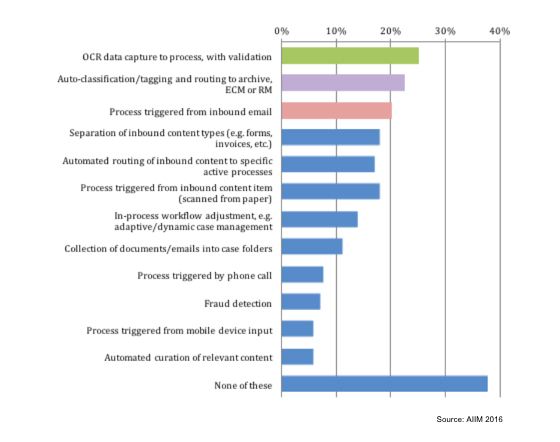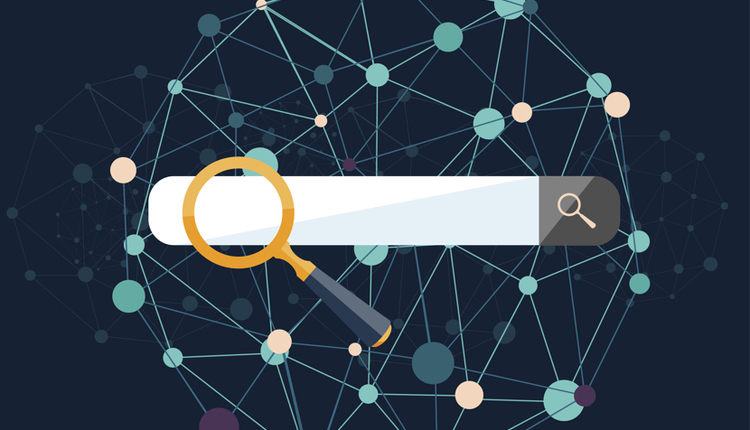
Image by: manfeiyang, ©2016 Getty Images
Something to consider when discussing analytics for process automation and business insight is that information can be, and is being, captured from multiple sources, including social media, blogs, websites, and even remote devices—the Internet of things (IoT). This means that attention must be paid to every element of inbound information. It must be recognized, analyzed, classified, and used to trigger related processes for business transaction.
A recent report by AIIM titled "Using Analytics - automating processes and extracting knowledge" finds that content analytics is driving auto-classification for tagging and routing to archive by 22% of respondents. Twenty percent indicate they trigger inbound processes based on content analytics used for inbound content.
While this may seem to be a small number, it is clear there is a focus by these organizations as to how they want to use their analytics capabilities, which begs the question, "When will the rest of business organizations catch onto the benefit that can be realized from the combination of analytics and process automation?"

In a recent report, AIIM asked respondents if they use content analytics for any of these inbound content functions.
Consider this
Analytics allow businesses to gain greater insight into their customer trends, operational processes, and can even aid in diagnostics. Today, we have information coming in from all sources, like email, social media, and remote devices. The amount of information flowing into a business organization is growing at exponential rates, making it difficult for humans to effectively identify, classify, and track it all.
Imagine having the ability to automate these actions to the degree that the only human interaction required is processing exceptions or for validation purposes. The possibility is here and in use by some organizations, with better than expected results. The key is having focus, and that focus must serve a business purpose, such as identifying, classifying, and processing inbound invoices or monitoring and reacting to customer inquiries and complaints.
What to think about
The combination of analytics and process automation is a powerful blend that can free up human resources for other more innovative activities, removing the mundane or tedious elements of day-to-day business. It can also be used to gain valuable insight into how your customers react to changes in your business offerings, services, and interactions related to information access. The question to ask before all others is a simple one: What business issue or opportunities are you trying to address? Is it slow processing times, an inability to identify and act upon inbound information effectively, or perhaps, to gain greater insight into your business operations? Until you can identify the true purpose and establish measurements from which you can determine return on investment (ROI) or corrective actions to take that bring expected benefits, you cannot expect to have stellar results or to solve problems.
In my view
Combining analytics with process automation serves multiple purposes. Not only does it allow for the automation of inbound processes that could also trigger additional transactional processes, it uncovers information that may once have been hidden from the organization—it provides greater levels of business insight.
The year 2016 is coming to a close, and as 2017 approaches, I encourage you to investigate how analytics and process automation can benefit your organization. You do not have to take a global view, but consider looking at an inbound process. Identify the types of information entering that process, and look at how it is identified, classified, and triggers the next process for action. Ask the question of how analytics can help in the areas of recognition as to what the information is, auto-classification to assign proper security retention controls, and searchable metadata. Once this is captured, assess how it can trigger additional processes based on your business rules, and identify additional areas where this information may be of use, as in case files.
As with any technology, analytics and process automation gains the greatest benefit when applied to resolve a business problem and enhance operations. It is essential that you focus your efforts rather than implement technology for technology's sake. I would like nothing more in 2017 than to see a significant increase of focused efforts in the area of analytics and process automation and hear about the successes gained as a result of their use.
Bob Larrivee is Vice President and Chief Analyst of Market Intelligence at AIIM and an internationally recognized subject matter expert and thought leader with over 30 years of experience in the fields of information and process management. He is an avid techie with a focus on process improvement and the application of advanced technologies to enhance and automate business operations. Follow him on Twitter @BobLarrivee.
















